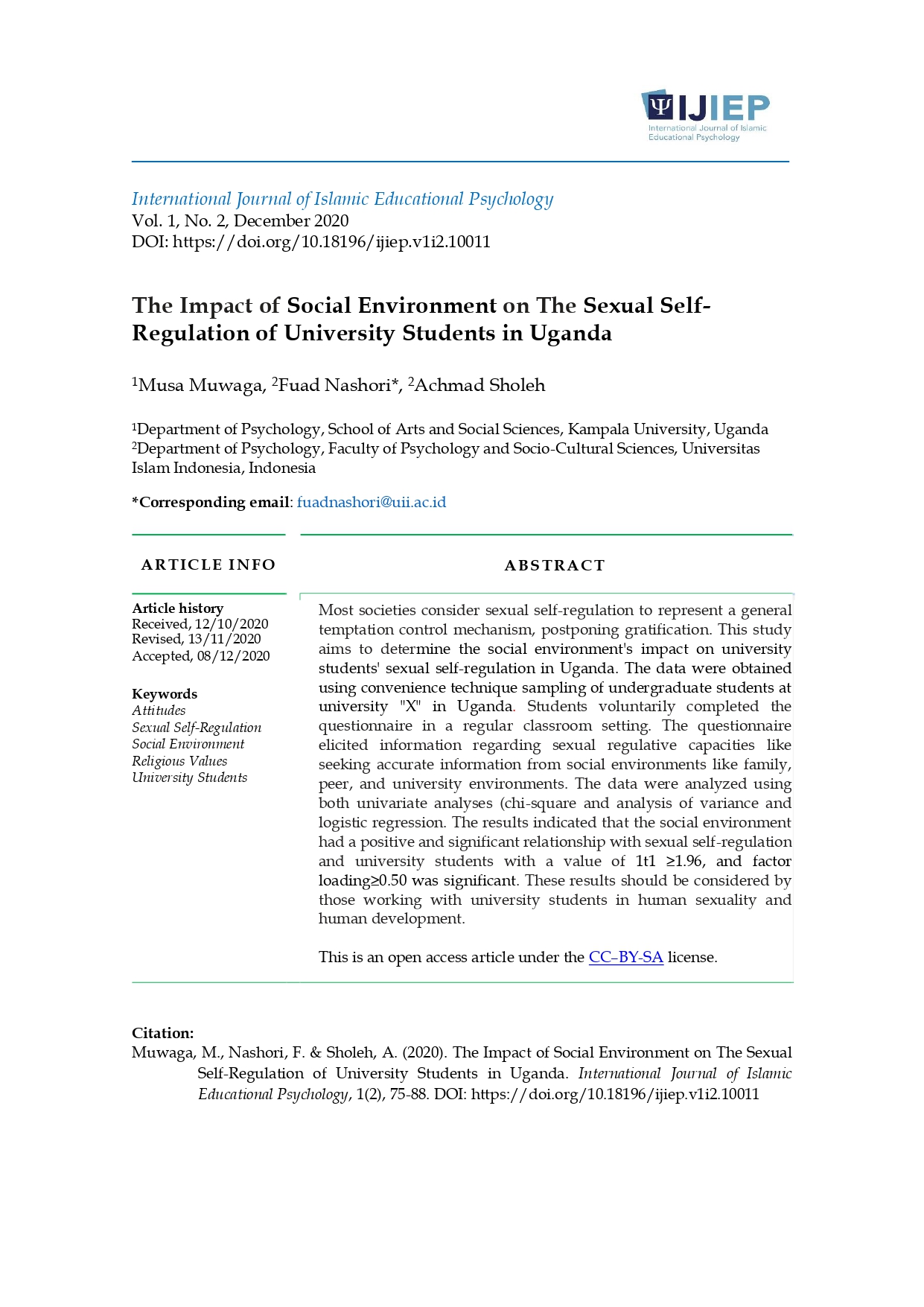The Impact of Social Environment on the Sexual Self-Regulation of University Students in Uganda
DOI:
https://doi.org/10.18196/ijiep.v1i2.10011Keywords:
Attitudes, Sexual Self-Regulation, Social Environment, Religious Values, University StudentsAbstract
Most societies consider sexual self-regulation to represent a general temptation control mechanism, postponing gratification. This study aims to determine the social environment's impact on university students' sexual self-regulation in Uganda. The data were obtained using convenience technique sampling of undergraduate students at university "X" in Uganda. Students voluntarily completed the questionnaire in a regular classroom setting. The questionnaire elicited information regarding sexual regulative capacities like seeking accurate information from social environments like family, peer, and university environments. The data were analyzed using both univariate analyses (chi-square and analysis of variance and logistic regression. The results indicated that the social environment had a positive and significant relationship with sexual self-regulation and university students with a value of 1t1 ≥1.96, and factor loading≥0.50 was significant. These results should be considered by those working with university students in human sexuality and human development
References
Adamczyk, A., & Hayes, B. E. (2012). Religion and sexual behaviors: Understanding the influence of Islamic cultures and religious affiliation for explaining sex outside of marriage. American Sociological Review, 77(5), 723–746. https://doi.org/10.1177/0003122412458672
Agardh, A., Emmelin, M., Muriisa, R., & Östergren, P.-O. (2010). Social capital and sexual behavior among Ugandan university students. Global Health Action, 3(1), 5432. https://doi.org/10.3402/gha.v3i0.5432
Ariho, P., & Kabagenyi, A. (2020). Age at first marriage, age at first sex, family size preferences, contraception and change in fertility among women in Uganda: analysis of the 2006–2016 period. BMC Women's Health, 20(1), 8. https://doi.org/10.1186/s12905-020-0881-4
Barnett, E., & Casper, M. (2001). A definition of "social environment." American Journal of Public Health, 91(3), 465a – 465. https://doi.org/10.2105/AJPH.91.3.465a
Blanchard, R., Zucker, K. J., Siegelman, M., Dickey, R., & Klassen, P. (1998). The relation of birth order to sexual orientation in men and women. Journal of Biosocial Science, 30(4), 511–519. https://doi.org/10.1017/S0021932098005112
Fried, R. A. (2015). No Irish Need Deny: Evidence for the Historicity of NINA Restrictions in Advertisements and Signs. Journal of Social History, 49(4), 829–854. https://doi.org/10.1093/jsh/shv066
Frost, D. M., & Meyer, I. H. (2009). Internalized homophobia and relationship quality among lesbians, gay men, and bisexuals. Journal of Counseling Psychology, 56(1), 97–109. https://doi.org/10.1037/a0012844
Hayes, D., Blake, J. J., Darensbourg, A., & Castillo, L. G. (2015). Examining the academic achievement of Latino Adolescents. The Journal of Early Adolescence, 35(2), 141–161. https://doi.org/10.1177/0272431614530806
Hines, M., Brook, C., & Conway, G. S. (2004). Androgen and psychosexual development: Core gender identity, sexual orientation, and recalled childhood gender role behavior in women and men with congenital adrenal hyperplasia (CAH). Journal of Sex Research, 41(1), 75–81. https://doi.org/10.1080/00224490409552215
Iskandar, Z., Setiono, K., Agustiani, H., & Musa, M. (2013). The influence of value systems and sexual self-regulation towards adolescent's sexuality. Indian Journal of Positive Psychology, 4(2), 315–320. https://doi.org/10.15614/ijpp/2013/v4i2/49914
Kendler, K. S., Thornton, L. M., Gilman, S. E., & Kessler, R. C. (2000). Sexual orientation in a U.S. national sample of twin and nontwin sibling pairs. American Journal of Psychiatry. https://doi.org/10.1176/appi.ajp.157.11.1843
Lauren, W., & Sharlene, S. (2012). adolescence. In J. Hardman (Ed.), Child and adolescent development: A South African sociocultural perspective (pp. 203–244). Oxford University Press.
Leung, H., Shek, D., Leung, E., & Shek, E. (2019). Development of contextually-relevant sexuality education: Lessons from a comprehensive review of adolescent sexuality Education Across Cultures. International Journal of Environmental Research and Public Health, 16(4), 621. https://doi.org/10.3390/ijerph16040621
Mikami, A. Y., Ruzek, E. A., Hafen, C. A., Gregory, A., & Allen, J. P. (2017). Perceptions of relatedness with classroom peers promote adolescents' behavioral engagement and achievement in secondary school. Journal of Youth and Adolescence, 46(11), 2341–2354. https://doi.org/10.1007/s10964-017-0724-2
Mujiyati, M., & Adiputra, S. (2018). Influence of peer groups to the self-esteem of Lampung and Javanese Students. International Journal of Psychology and Educational Studies, 5(1), 15–22. https://doi.org/10.17220/ijpes.2018.01.003
Noviva, H., & Wahyono, T. Y. M. (2020). Factors associated with risky sexual behavior in adolescent boys in Indonesia. Proceedings of the 2nd Sriwijaya International Conference of Public Health (SICPH 2019). https://doi.org/10.2991/ahsr.k.200612.040
Quinn, D., & Lewin, A. (2019). Family religiosity, parental monitoring, and emerging adults' sexual behavior. Religions, 10(2), 114. https://doi.org/10.3390/rel10020114
Ragelienė, T. (2016). Links of adolescents identity development and relationship with peers: A systematic literature review. In Journal of the Canadian Academy of Child and Adolescent Psychiatry.
Ridge, S. R., & Feeney, J. A. (1998). Relationship History and Relationship Attitudes in Gay Males and Lesbians: Attachment Style and Gender Differences. Australian & New Zealand Journal of Psychiatry, 32(6), 848–859. https://doi.org/10.3109/00048679809073875
Rosario, M., Schrimshaw, E. W., Hunter, J., & Braun, L. (2006). Sexual identity development among lesbian, gay, and bisexual youths: Consistency and change over time. Journal of Sex Research, 43(1), 46–58. https://doi.org/10.1080/00224490609552298

Downloads
Published
How to Cite
Issue
Section
License

- Share — copy and redistribute the material in any medium or format
- Adapt—remix, transform, and build upon the material for any purpose, even commercially.
The licensor cannot revoke these freedoms as long as you follow the license terms. Under the following terms:
- Attribution: You must give appropriate credit, provide a link to the license, and indicate if changes were made. You may do so in any reasonable manner, but not in any way that suggests the licensor endorses you or your use.
- ShareAlike: If you remix, transform, or build upon the material, you must distribute your contributions under the same license as the original.
- No additional restrictions — You may not apply legal terms or technological measures that legally restrict others from doing anything the license permits.






